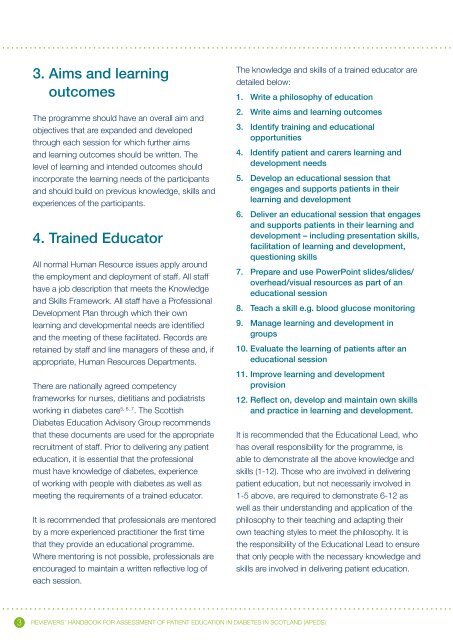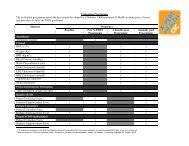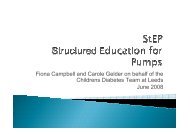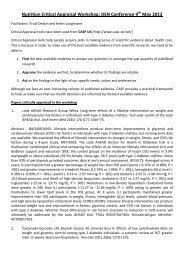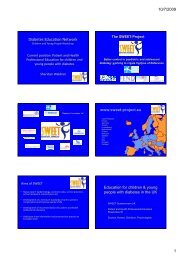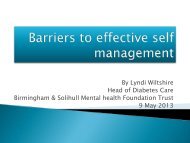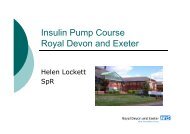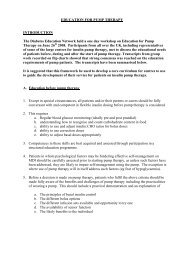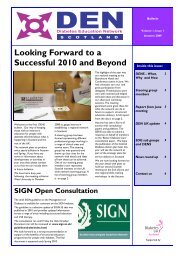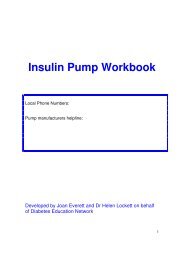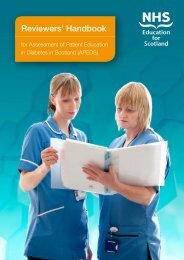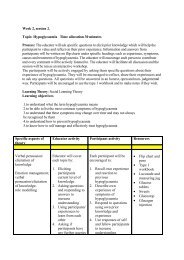Tool for the Assessment of Patient Education in Diabetes in Scotland ...
Tool for the Assessment of Patient Education in Diabetes in Scotland ...
Tool for the Assessment of Patient Education in Diabetes in Scotland ...
Create successful ePaper yourself
Turn your PDF publications into a flip-book with our unique Google optimized e-Paper software.
3. Aims and learn<strong>in</strong>goutcomesThe programme should have an overall aim andobjectives that are expanded and developedthrough each session <strong>for</strong> which fur<strong>the</strong>r aimsand learn<strong>in</strong>g outcomes should be written. Thelevel <strong>of</strong> learn<strong>in</strong>g and <strong>in</strong>tended outcomes should<strong>in</strong>corporate <strong>the</strong> learn<strong>in</strong>g needs <strong>of</strong> <strong>the</strong> participantsand should build on previous knowledge, skills andexperiences <strong>of</strong> <strong>the</strong> participants.4. Tra<strong>in</strong>ed EducatorAll normal Human Resource issues apply around<strong>the</strong> employment and deployment <strong>of</strong> staff. All staffhave a job description that meets <strong>the</strong> Knowledgeand Skills Framework. All staff have a Pr<strong>of</strong>essionalDevelopment Plan through which <strong>the</strong>ir ownlearn<strong>in</strong>g and developmental needs are identifiedand <strong>the</strong> meet<strong>in</strong>g <strong>of</strong> <strong>the</strong>se facilitated. Records arereta<strong>in</strong>ed by staff and l<strong>in</strong>e managers <strong>of</strong> <strong>the</strong>se and, ifappropriate, Human Resources Departments.There are nationally agreed competencyframeworks <strong>for</strong> nurses, dietitians and podiatristswork<strong>in</strong>g <strong>in</strong> diabetes care 5, 6, 7 . The Scottish<strong>Diabetes</strong> <strong>Education</strong> Advisory Group recommendsthat <strong>the</strong>se documents are used <strong>for</strong> <strong>the</strong> appropriaterecruitment <strong>of</strong> staff. Prior to deliver<strong>in</strong>g any patienteducation, it is essential that <strong>the</strong> pr<strong>of</strong>essionalmust have knowledge <strong>of</strong> diabetes, experience<strong>of</strong> work<strong>in</strong>g with people with diabetes as well asmeet<strong>in</strong>g <strong>the</strong> requirements <strong>of</strong> a tra<strong>in</strong>ed educator.It is recommended that pr<strong>of</strong>essionals are mentoredby a more experienced practitioner <strong>the</strong> first timethat <strong>the</strong>y provide an educational programme.Where mentor<strong>in</strong>g is not possible, pr<strong>of</strong>essionals areencouraged to ma<strong>in</strong>ta<strong>in</strong> a written reflective log <strong>of</strong>each session.The knowledge and skills <strong>of</strong> a tra<strong>in</strong>ed educator aredetailed below:1. Write a philosophy <strong>of</strong> education2. Write aims and learn<strong>in</strong>g outcomes3. Identify tra<strong>in</strong><strong>in</strong>g and educationalopportunities4. Identify patient and carers learn<strong>in</strong>g anddevelopment needs5. Develop an educational session thatengages and supports patients <strong>in</strong> <strong>the</strong>irlearn<strong>in</strong>g and development6. Deliver an educational session that engagesand supports patients <strong>in</strong> <strong>the</strong>ir learn<strong>in</strong>g anddevelopment – <strong>in</strong>clud<strong>in</strong>g presentation skills,facilitation <strong>of</strong> learn<strong>in</strong>g and development,question<strong>in</strong>g skills7. Prepare and use PowerPo<strong>in</strong>t slides/slides/overhead/visual resources as part <strong>of</strong> aneducational session8. Teach a skill e.g. blood glucose monitor<strong>in</strong>g9. Manage learn<strong>in</strong>g and development <strong>in</strong>groups10. Evaluate <strong>the</strong> learn<strong>in</strong>g <strong>of</strong> patients after aneducational session11. Improve learn<strong>in</strong>g and developmentprovision12. Reflect on, develop and ma<strong>in</strong>ta<strong>in</strong> own skillsand practice <strong>in</strong> learn<strong>in</strong>g and development.It is recommended that <strong>the</strong> <strong>Education</strong>al Lead, whohas overall responsibility <strong>for</strong> <strong>the</strong> programme, isable to demonstrate all <strong>the</strong> above knowledge andskills (1-12). Those who are <strong>in</strong>volved <strong>in</strong> deliver<strong>in</strong>gpatient education, but not necessarily <strong>in</strong>volved <strong>in</strong>1-5 above, are required to demonstrate 6-12 aswell as <strong>the</strong>ir understand<strong>in</strong>g and application <strong>of</strong> <strong>the</strong>philosophy to <strong>the</strong>ir teach<strong>in</strong>g and adapt<strong>in</strong>g <strong>the</strong>irown teach<strong>in</strong>g styles to meet <strong>the</strong> philosophy. It is<strong>the</strong> responsibility <strong>of</strong> <strong>the</strong> <strong>Education</strong>al Lead to ensurethat only people with <strong>the</strong> necessary knowledge andskills are <strong>in</strong>volved <strong>in</strong> deliver<strong>in</strong>g patient education.3REVIEWERS’ HANDBOOK FOR ASSESSMENT OF PATIENT EDUCATION IN DIABETES IN SCOTLAND (APEDS)


